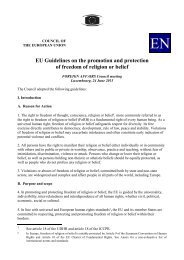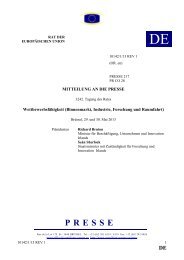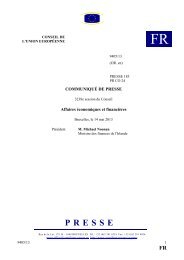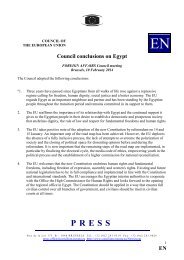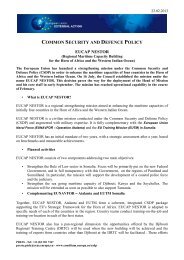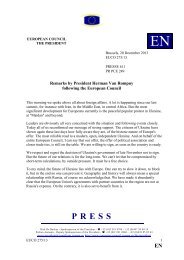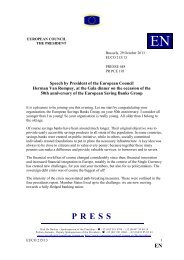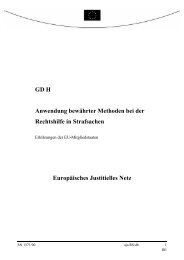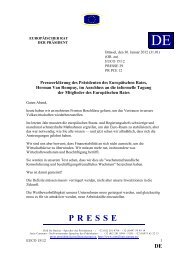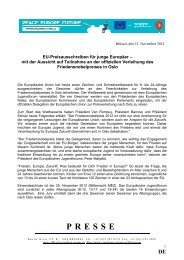14508/09 ADD 1 PL/vk 1 DG G COUNCIL OF THE ... - Europa
14508/09 ADD 1 PL/vk 1 DG G COUNCIL OF THE ... - Europa
14508/09 ADD 1 PL/vk 1 DG G COUNCIL OF THE ... - Europa
Create successful ePaper yourself
Turn your PDF publications into a flip-book with our unique Google optimized e-Paper software.
egards the latter, it can be noted that two MS report special national action plans on this issue (RO<br />
on Roma women and ES on ethnic minority women) and some examples of policy development<br />
regarding violence in the name of honour can also be seen. In Sweden, the national plan of action to<br />
combat violence against women included honour-related violence and oppression, and in Austria, a<br />
violence-prevention campaign in 2008 included material on this form of violence. A tentative<br />
conclusion that can be drawn from these examples is that there may be a growing recognition within<br />
the EU MS of diversity both as regards forms of violence against women and women subjected to<br />
violence.<br />
When looking at the reporting of progress in policy areas other than criminal law and specialised<br />
violence work, it becomes clear that the development of integrated measures to prevent and<br />
eliminate violence against women remains a challenge. Some scholars in the field have pointed out<br />
contradictions between different aspects of policy on violence against women and children, often<br />
leading to contradictory outcomes and lack of safety-oriented practice (e.g. Eriksson and Hester<br />
2001; Hester 2004; Humphreys and Carter et al. 2006). Underpinning this analysis is the<br />
observation that different policy domains tend to have their own separate cultures and professionals,<br />
with different institutional discourses and practices that create difficulties in linking the work on<br />
victim protection and support, with, for example, child protection, family law proceedings, or<br />
practice in relation to immigration and asylum-seeking.<br />
A challenge for the future is the creation of a strong focus on evaluating the work in this field. Some<br />
MS' reports suggest an increase in the attention paid to monitoring and evaluation of policy and<br />
practice. In many countries awareness-raising campaigns have been organised, directed at<br />
professionals, the general public, and/or special target groups such as young people. In addition,<br />
many different examples of training of professionals have been provided. Even so, it is unclear how<br />
systematic such training has been, to what extent training has improved practice, to what extent<br />
general attitudes to violence against women have changed, and so forth. In terms of evaluating<br />
policy and practice, two countries report a decrease in the prevalence of violence against women<br />
(DK, UK).<br />
<strong>14508</strong>/<strong>09</strong> <strong>ADD</strong> 1 <strong>PL</strong>/<strong>vk</strong> 74<br />
ANNEX <strong>DG</strong> G EN



